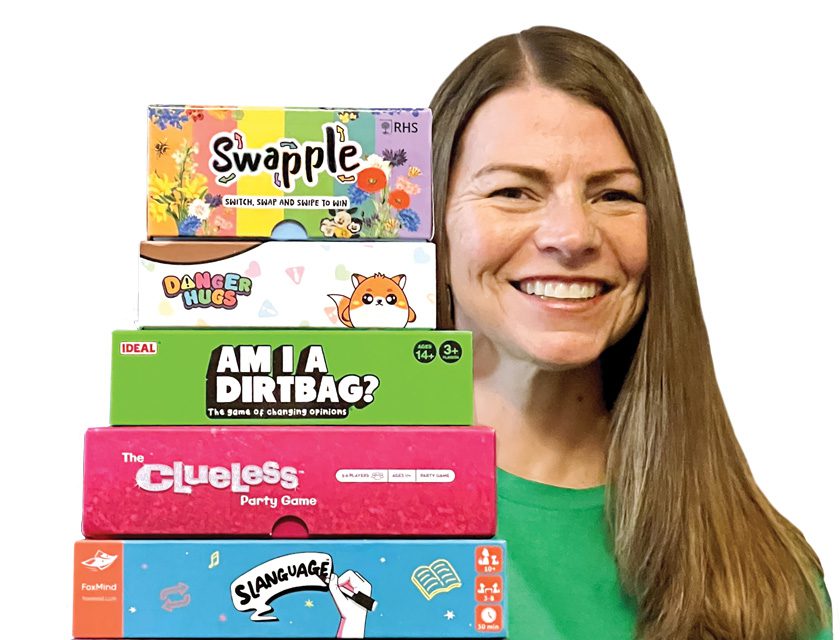
Aaron Muderick walked away from his life’s dream to build a creative and purposeful toy empire
BY REID CREAGER
He said it. He doesn’t care how weird it sounds. He’s not taking it back.
The creative tsunami behind the desk toy and stress reliever Thinking Putty—and founder of Crazy Aaron’s, a physical and online wonderland of goopy, slimy stuff and special dough to captivate and engage the senses—is a software engineer-turned inventor/entrepreneur with a child’s energy, curiosity and vision who employs hundreds of developmentally disabled people.
It’s no stretch to say that putty is the anchor of all this. Magnetic putty. Putty that changes color as you finesse it with your palms and through your fingers. Putty that molds, sculpts, stretches, pops, and tears.
Putty that can improve the lives of its users. Putty that can change the lives of those involved with distributing and creating it.
Our interview with Muderick revealed part storytelling, part chemistry lesson, part business advice, part sound effects. The highlight was revisiting the day in 2002 when he was called into the “principal’s office” at his corporate job, politely responded to an ultimatum, and embarked on a daring journey of self-discovery and accomplishment that surprised even himself.
All in on computers
He grew up in the Philadelphia suburb of Havertown, Pennsylvania. So did Richard T. James, who invented the Slinky. But if Muderick was destined to be in the toy business, it wasn’t apparent for a long time.
A self-proclaimed child of the ’80s, when technology was exploding into realms such as computers and video games, Muderick found his inner nerd early in life. It didn’t hold him back; it embraced him back.
“The personal computer revolution was something I was completely immersed in,” he says. “My father won a VIC-20 computer as a door prize at some corporate event in 1982, and I was off to the races.
“I wanted to understand it, program it, make my own games. That led me to high school—running an independent computer consulting business, managing small computer networks and offices, helping people who weren’t maybe as obsessed with all the ins and outs of technology.”
A prodigy with a prodigious resumé before college, he majored in computer science and was “100 percent going to be in computers. I was 100 percent committed to everything that was happening in Silicon Valley: ‘How can I get there? How can I make an impact?’ It seems fun and amazing, building the future.”
He landed a job at Apple, where he, in his inimitable words, “got to see how the sausages were made. It was amazing. But what it really came down to is that the only person who gets to be Steve Jobs is Steve Jobs. That was a great lesson.”
Returning to his hometown, he landed some other computing jobs but fought escalating boredom.
“I was so committed to this identity of being a software engineer. I was building web apps in Philadelphia, definitely pushing the boundaries of what was possible. But as I got more and more fidgety, I was looking for something—and there was something at my desk.
“It happened to be an egg of putty.”
Beep … mrrrp … hmmm
Over time, Muderick noticed that his putty was getting smaller. One day, he told coworkers that he was leaving his cubicle to get lunch. He doubled back and discovered they were stealing pieces to play with.
Medical journals and Psychology Today have written about the latent but real neurological and emotional benefits of fidget toys for children and adults, how they may also help improve symptoms of depression, anxiety and cognitive decline. Muderick doesn’t read the studies. “I just go with what my gut tells me.”
But he does know that the world is increasingly becoming a place where stress relief is crucial. “I get letters about how my putty is being used by children in courtrooms who have to discuss difficult topics as witnesses, or those who have self-destructive behaviors like picking their hair or cutting their skin.”
After convincing a Silly Putty manufacturer to send him 100 pounds of the stuff, and selling it at cost to coworkers and others, he realized that a more cost-effective solution would be to make the putty himself.
Although money mattered, Muderick was more interested in entertaining himself by creating new chemical combinations. Except he knew nothing about chemistry.
“But I did have a high school friend who was going to grad school to get a PhD. I called and asked for her old textbooks—and one thing I’m good at is hoovering up a textbook. So I just started teaching myself chemistry so that I would understand enough of what’s happening to solve my problem.”
He founded Crazy Aaron’s in 1998, a fun side pursuit. Fast-forward to that day of reckoning in the principal’s office; the names and company will be withheld to protect the unenlightened.
“I’m still working for someone else, writing code, sort of designing the IT systems. I was selling putty under my desk in baggies and on eBay, so it was more than just friends and family at that point.”
Eventually, he determined that selling in metal tins made more sense because it was neater, recyclable, and something that would be a better fit on an executive’s desk.
“You can have a metal tin on your desk in a serious law office. But you can’t have like a crazy plastic baaaaaag sitting there.
“I knew how to build websites. I was building them for clients. I remember seeing a vitamin website. I saw how much, in dollars, this gentleman was selling every day—I’ll be honest, selling snake oil.
“And I said to myself, gosh, Aaron, you think you’re selling a lot to friends and family. You think you’re selling a lot on eBay. But there’s a much bigger world out there than you can even conceive.”
So he built a website for Putty World—Crazy Aaron’s first website—and focused on Web-saleable products. Then he connected the website to his phone, which was rare in those days. But not for a nerd.
“Every time I would get an order, I would get a little buzz. … So I would be sitting in a meeting, and people are droning on about connecting a bank to an insurance company or something and I’m trying to pay attention.
“And my phone would go, beep … mrrrp … wooom …and I’m looking down and I go, ‘Hmm, there’s 100 bucks. There’s 150 bucks. There’s 200 bucks.’”
Showdown at the walnut desk
In September 2002, Wall Street Journal reporter Susan Warren called after being alerted to Muderick’s website. She was doing a story about grown-ups playing with putty at their desks.
He went to the parking lot, gave her a 20-minute interview and forgot about it—until it was a front-page story the next day.
The website went gazooey. He was “riding high, which is not unusual when one of my shenanigans sort of catches on, right?” Then there was being faced with the specter of staying up nights and weekends trying to make enough putty and fill all the orders.
He was also face to face with an unhappy boss.
“You know who reads the Wall Street Journal? Well, the CEOs, right? So, the CEO of the company I was working for, maybe a 150-person consulting company, sits back at his big walnut desk and opens his Wall Street Journal that his secretary has placed there with his coffee.
“And he sees … me.”
Muderick, soon to become Crazy Aaron Muderick full time, was paged over the loudspeaker at the company: “Please report to the principal’s office,” he recalled with a smile and his best loudspeaker voice.
“So I go to the office with the big walnut desk that needs an even bigger room with sort of that point-five look where you’re like, walking in and you’re walking to the desk for an hour and you’re still not at the desk yet.
“I sit down in the giant chair that makes even me look small and he said, ‘What is this?’
After informing Walnut Desk Guy about his side hustle that was not a hustle, Muderick says he was told, “We really don’t encourage moonlighting here. You need to be fully focused on your job. So I need you to think about it and make a decision.”
He recalls the “terror” of being told his job was on the line—with a phone in his pocket that was buzzing with orders.
So what was it going to be? The job, or the putty?
“Writing banking and insurance code, it just wasn’t in my heart. I don’t think I thought about it for 5 seconds. I said, ‘Well, I guess it’s the putty. And thank you very much.’”
A winding learning curve
This was not as simple as the conversation, or even as simple as Muderick’s passion.
He had been working in computers since he was a young boy. He had “never been a guy to walk out the door.” Even if he left a computer job, it was to eventually go to another computer job.
So he looked straight at his learning curve from as many angles as he could. He didn’t understand accounting. Didn’t understand purchasing. “I didn’t understand why all the companies I was trying to buy from were hanging up on me. When I said, ‘Hi, I’m Crazy Aaron and I would like to buy Chemical X,’ they would just ‘Click.’”
The manufacturing came in baby steps as his chemistry acumen and confidence congealed. Initially, he would buy completed synthesized polymer, then add modifiers and colors. But as he came to understand the original materials in those substances, he made the polymers himself and experimented with different time durations and temperatures.
Muderick explains that putty is primarily silicone—a silicone rubber. “The raw materials are raw, industrial silicon. They have to be polymerized and then all kinds of modifiers added to give it the properties you want.
“Originally, it happened in a heavy-duty contractor bag. I would pour things in and work on top of a hot plate and would just, with my feet, using my body weight, beat it up, tie it off—until I felt like it was done. Open it up and then consider coloring it or adding to the ‘special sauces.’
“Then I learned that with machines, I don’t have to kill myself making this stuff because it’s thick and viscous.”
His putty empire has expanded to the point where he can’t pin down how many different ones he makes. It has been over 300 but now at least 50 at any given time, he says.
Until 2019, all the putty creations were uniquely his. Muderick eventually realized “this was killing me, because the company was growing, the demands of the market were growing, and I just couldn’t keep doing it.
“When you bring more voices in, you bring more ideas in, to riff off what you’ve done. It’s gonna help everybody.”
He says this is especially true with people who are in chemistry and chemical engineering who are creative but not in jobs that support that creativity. “So I can find those people and bring them into the organization. That’s the Venn diagram to bring the wonder by connecting creativity and science.”
Protecting people and product
Bringing the wonder is the essence of Crazy Aaron’s.
For years, the company has hired hundreds of developmentally disabled people—providing jobs, hope, and a uniquely satisfying form of teamwork. Handi-Crafters, which has packaged millions of tins of Crazy Aaron’s Thinking Putty, recently honored Muderick with its Best Friend Award.
Pre-COVID, the company employed up to 800 such individuals to work at its offices in Norristown, Pennsylvania and around the Philadelphia area; that number is around 200 today. It seeks out social service agencies to find prospective workers and instill a sense of purpose in their lives.
“We have people in a variety of positions because intellectual and physical disabilities can take many forms,” Muderick says. “I don’t look at people’s medical histories when we hire them. They bring problem solving and added voices.”
Their duties run the gamut, including assembling and shipping.
“There are certain tasks where you need two hands and fine motor skills. There are other individuals who sort of have superhuman qualities, placing labels exactly straight and perfect every time—like, ‘Don’t talk to me. I’ll do 5,000.’”
With so much at stake for so many, protecting the company is paramount. Patents aren’t a part of that, but trademarks and trade secrets are.
Especially with putty, Muderick says the patent system was not the solution: “One, a lot of things have already been invented so it’s hard to get patents and good claims. Two, you are responsible for the financial burden of protecting your patent—going after people. That is expensive.”
He relies heavily on trade secrets but says they will only take you so far. “If someone figures it out, you’re done.” It’s crucial to create and maintain strong branding—“sticking with it, really being mindful of the brand and how it is perceived by customers, whether it’s the brand name or the Crazy Aaron head.”
This is where trademark protection comes in, about 60 or 70 strong. His office has a “Wall of Shame” filled with copycats who did not even bother to change the Crazy Aaron cartoon head.
“The fun and whimsical names—those are the things most often copied and knocked off. But through trademark protection, we’re able to protect and police the marketplace much more cost-effectively than we ever could with a patent.”
Grassroots success endures
Always looking to help others, Muderick warns prospective inventors seeking quick riches that there are other, easier ways to go.
Real success is “starting grassroots and building slowly over time. One thing when I talk to inventors, everybody wants to make a product, go on ‘Shark Tank,’ and be a great success.
“I’ve been doing this for 26 years, right? And you and I are just talking now, right? You go low and slow, you have a good idea, you stick with it. …
“By going through grassroots, you are able to build that kind of brand dominance so that people really expect what your company is delivering and it just seeps in through the cracks in the concrete, slowly over time.”
More play, more dough
Crazy Aaron’s isn’t just about the putty. Not since 2019, anyway.
That’s when the company launched Land of Dough, which it calls the world’s most eco-friendly dough. A kind of play dough reimagined, it features cups full of dough with only natural colors, ethically sourced ingredients, compostable glitter and eco-friendly packaging.
Land of Dough cups have multi-layered designs and fun themes, such as Planet Earth and Over the Rainbow. Land of Dough wood play tools are included in the Rolling Patterns and Learning Numbers Kits.
Aaron Muderick
Born: Havertown, Pennsylvania
Home: Narberth, Pennsylvania
Personal: Single, two girls age 18 and 20.
Education: Bachelor of Science in computer science, University of Rochester
Awards: Baker Industries Person of the Year 2022, Handi-crafters Best Friend Award 2024
Hobbies: Volunteer firefighter, film photography and unusual darkroom chemistry, hiking, caving, collecting playing cards I find in the street.
Craziest business stunt: Finding a (legal) piece of the moon, grinding it up and making a special commemorative Moon-Edition Thinking Putty.
Favorite book: “Godel Escher Bach, an Eternal Golden Braid,” by Douglas Hofstadter
Favorite movie: “Fargo”
Favorite song: “Shine On You Crazy Diamond,” Pink Floyd
Favorite saying: “And it’s a beautiful day!”



